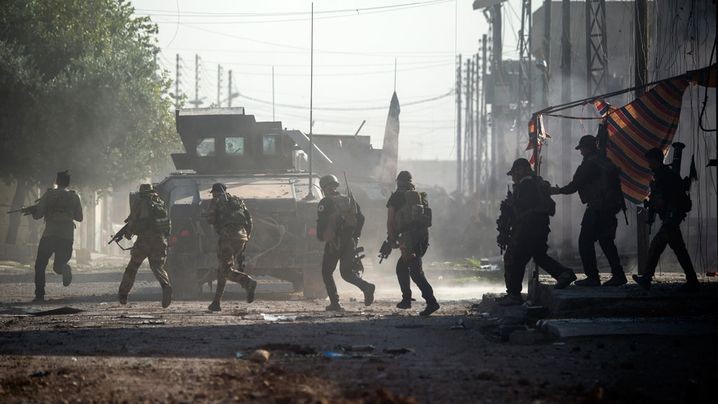Iraqi Special Forces 2nd division soldiers come under fire from ISIS while running across an intersection = in the Karkukli neighbourhood of Mosul on November 13, 2016. (AFP)
Iraqi forces said Sunday they had recaptured the Nimrud area, the site of an ancient Assyrian city blown up by ISIS, as they battled the jihadists south of Mosul.
The troops pushed towards Nimrud last week as they pressed an offensive launched on October 17 to recapture Iraq’s second city, which the jihadists seized along with swathes of Iraq and Syria in mid-2014.
A Kurdish-Arab alliance is pursuing a twin offensive against the other major city still under ISIS control, Raqa in Syria, and a US-led coalition is backing both assaults with air strikes.
On Sunday Iraq’s Joint Operations Command (JOC) said troops had retaken the Nimrud area and another village southeast of the famed archeological site.
“Units of the 9th Armoured Division completely liberate the Nimrud (area) and raise the Iraqi flag over the buildings,” the JOC said in a statement.
It did not specifically mention the Nimrud archaeological site, located a little more than a kilometre west of the village that bears its name.
Nimrud was the one of the great centres of the ancient Middle East. Founded in the 13th century BC, it became the capital of the Assyrian empire, whose rulers built vast palaces and monuments that have drawn archaeologists for more than 150 years.
In April last year, ISIS posted a video on the Internet of its fighters smashing monuments before planting explosives around the site and blowing it up.
ISIS destruction campaign
It was part of a campaign of destruction against heritage sites under jihadist control that also took in ancient Nineveh on the outskirts of Mosul, Hatra in the desert to the south and Palmyra in neighbouring Syria.
ISIS says the ancient monuments are idols that violate the teachings of its extreme form of Sunni Islam, but it has still sold artefacts to fund its operations.
The United Nations Educational, Scientific and Cultural Organisation welcomed the news of Nimrud’s recapture.
“We welcome the news that Nimrod, a UNESCO world heritage site, is back under the control of the Iraqi government,” said spokesman George Papagiannis.
“We look forward to coordinating with the relevant authorities in Baghdad on providing support for any assessments that need to be done of the site, once the area has been stabilised.”
The Iraqi offensive has seen federal forces and Kurdish peshmerga fighters advance on Mosul from the east, south and north.
The elite Counter-Terrorism Services (CTS) have pushed into the eastern outskirts of Mosul, with heavy fighting in recent days.
Staff Lieutenant Colonel Muntadhar Salem of the CTS told AFP on Sunday that its forces were looking to move into a new eastern neighbourhood.
“Our goal today is to clear out (ISIS) from the western part of Karkukli,” he said.
North of Karkukli in the neighbourhood of Arbajiyah, CTS forces were facing sniper fire as they moved street-to-street clearing houses.
On the edge of Mosul, dozens of civilians could be seen walking towards a gathering point from where they would be taken to a camp for the displaced. A dozen men swarmed around a barber shop for a shave.
In neighbouring Syria, the US-backed Syrian Democratic Forces (SDF) militia alliance has moved to about 30km from Raqa since launching its offensive a week ago.
Commanders have said the SDF is close to completing a first phase of the operation to surround and isolate Raqa before launching an assault on the city itself.
The jihadists are putting up fierce resistance in both Mosul and Raqa, and military commanders have warned of long and difficult battles ahead.
Turkey has launched its own operation against ISIS just south of its border in Syria and a monitor said Sunday that Ankara-backed rebels had neared the ISIS stronghold of Al-Bab.
Turkey-backed rebels near IS bastion
The rebels had moved to about two kilometres from Al-Bab, as Turkish forces targeted the town with artillery fire and air strikes, the Syrian Observatory for Human Rights said.
Ankara launched its unprecedented cross-border operation saying it was targeting both ISIS and the Kurdish People’s Protection Units (YPG) militia, which has been a key opponent of the jihadist group and dominates the SDF.
Turkey considers the YPG a “terrorist” organisation, and wants to avoid the creation of a contiguous, semi-autonomous Kurdish zone along the Syrian border.
Kurdish forces have also played a major role in the battle against ISIS in Iraq.
Its autonomous Kurdish region has gained or solidified control over large areas claimed by both it and the federal government in Baghdad in the course of the war.
In a report on Sunday, Human Rights Watch said Iraqi Kurdish forces had demolished Arab homes and buildings in disputed areas in the country’s north.
HRW found “a pattern of apparently unlawful demolitions of buildings and homes, and in many cases entire villages, between September 2014 and May 2016”, the report said.
It raised concern that the destruction was “for the purpose of preventing or dissuading Arabs from returning” to the homes in order to strengthen Kurdish claims to the areas.
© AFP 2016


 ο ψηφοφόρος της κλανιόλας
ο ψηφοφόρος της κλανιόλας η εποχή ζητά ενσυναίσθηση, συνείδηση και συμμετοχή, πολιτική ανασκόπηση
η εποχή ζητά ενσυναίσθηση, συνείδηση και συμμετοχή, πολιτική ανασκόπηση γεωπολιτική για καμένους εγκεφάλους
γεωπολιτική για καμένους εγκεφάλους













